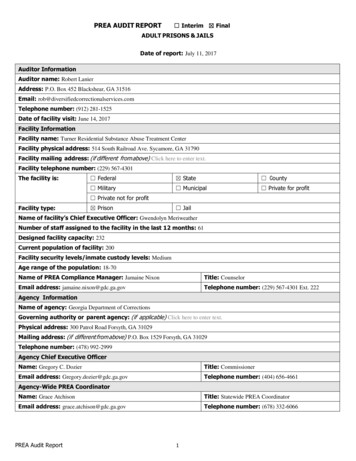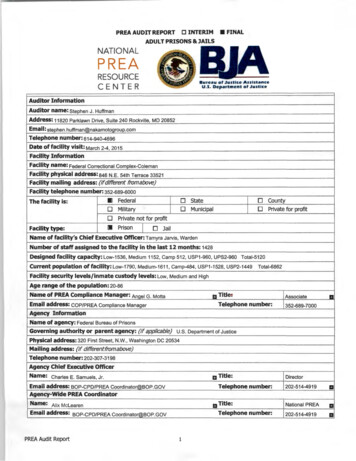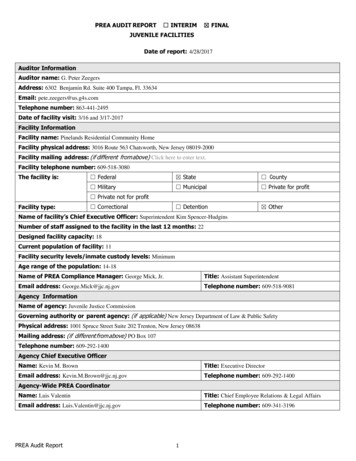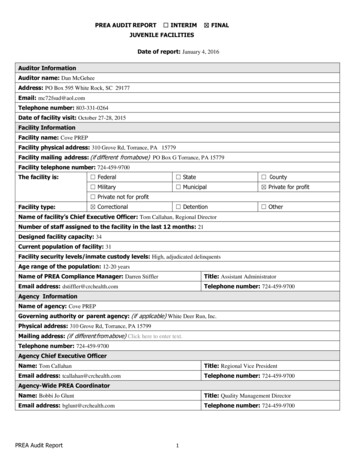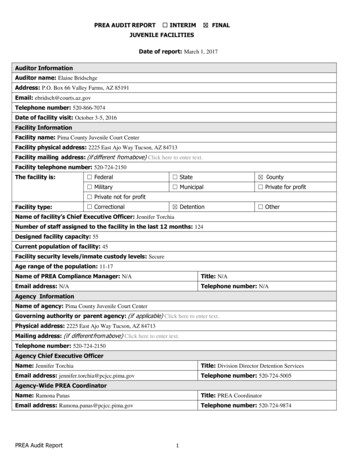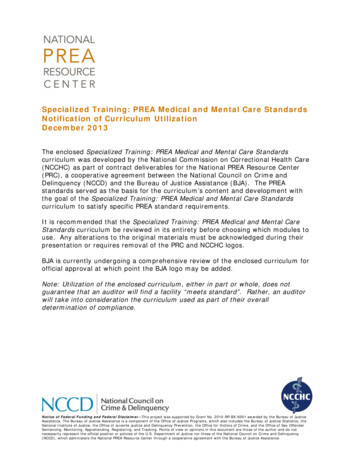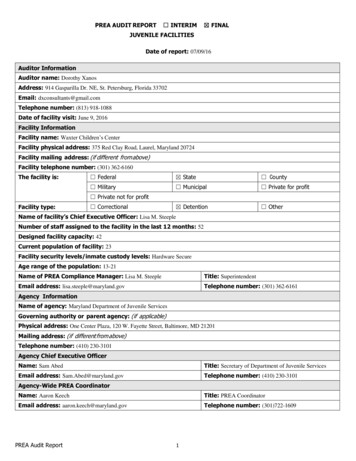
Transcription
PREA AUDIT REPORT INTERIM FINALJUVENILE FACILITIESDate of report: 07/09/16Auditor InformationAuditor name: Dorothy XanosAddress: 914 Gasparilla Dr. NE, St. Petersburg, Florida 33702Email: dxconsultants@gmail.comTelephone number: (813) 918-1088Date of facility visit: June 9, 2016Facility InformationFacility name: Waxter Children’s CenterFacility physical address: 375 Red Clay Road, Laurel, Maryland 20724Facility mailing address: (if different from above)Facility telephone number: (301) 362-6160The facility is: Federal State County Military Municipal Private for profit Detention Other Private not for profitFacility type: CorrectionalName of facility’s Chief Executive Officer: Lisa M. SteepleNumber of staff assigned to the facility in the last 12 months: 52Designed facility capacity: 42Current population of facility: 23Facility security levels/inmate custody levels: Hardware SecureAge range of the population: 13-21Name of PREA Compliance Manager: Lisa M. SteepleTitle: SuperintendentEmail address: lisa.steeple@maryland.govTelephone number: (301) 362-6161Agency InformationName of agency: Maryland Department of Juvenile ServicesGoverning authority or parent agency: (if applicable)Physical address: One Center Plaza, 120 W. Fayette Street, Baltimore, MD 21201Mailing address: (if different from above)Telephone number: (410) 230-3101Agency Chief Executive OfficerName: Sam AbedTitle: Secretary of Department of Juvenile ServicesEmail address: Sam.Abed@maryland.govTelephone number: (410) 230-3101Agency-Wide PREA CoordinatorName: Aaron KeechTitle: PREA CoordinatorEmail address: aaron.keech@maryland.govTelephone number: (301)722-1609PREA Audit Report1
AUDIT FINDINGSNARRATIVEThe Thomas J. S. Waxter Children’s Center (WCC) serves as a forty-two (42) bed secure detention facility for female residents governedby the Maryland Department of Juvenile Services (DJS). The detention facility is located in Anne Arundel County and primarily servesresidents from the Baltimore City, Baltimore County, Anne Arundel County, Howard County, Harford County and Carrol County.Typically, female residents are waiting to go to court or be placed in a treatment facility. There are other residents detained from otherjurisdictions that are pending transfers to nearby committed placements, special cases and/or disciplinary transfers from other DJSdetention facilities. The average age is between 13-18 years old although juvenile jurisdiction could remain until the age of 21. Theaverage length of stay is twenty-three (23) days. There were twenty-three (23) residents at the detention center at the time of the review.WCC is staffed with sixty-nine (69) full-time and part-time employees and thirty-five (35) contracted and volunteer staff. The detentionstaff consisted of: Superintendent; Assistant Superintendent; Mental Health Professional Counselor; Psychologist; Social Work I &Advisor; (2) Program Manager I & III; Case Management Specialist Supervisor; (4) Case Management Specialists II & III; (6) ResidentAdvisor Supervisors; (4) Resident Advisor Leads; (2) Residential Group Life Managers I & II; (22) Resident Advisors I & II; (11)Resident Advisor Trainees; Youth Transport Officer II and (10) other staff (Food Service, Maintenance and office).The medical staff consisted of: a licensed registered nurse supervisor, licensed registered nurse and contracted medical staff providingnursing services on-site twenty-four (24) hours a day, seven (7) days a week and an on-call physician. Additionally, all nurses aresupervised by an on-site registered nurse supervisor who is responsible for coordination of other medical services and medical clinics. Thedetention center has contracts with the local hospital for 24 hour emergency needs. A medical physician visits the detention facility weekly.Also, the nurses provide health education and counseling about a variety of topics. The medical staff provides medical care to include:completing the initial intake assessment, review intake referrals, routine and additional lab work as ordered, STD testing and treatment asindicated, updating immunization records, seasonal flu vaccinations, routine eye exams, dietary services and referrals, administration ofmedications/treatments as prescribed, assessments of resident injuries and treatment as required, medical assessments and monitoring withany restraint or seclusion, assessments of somatic health complaints with treatment as indicated, develop treatment plans and providemedical discharge plans. Several on-site medical clinics occur including a weekly medical clinic, a weekly mental health clinic, andparticipation in weekly treatment planning meetings. The dental staff consisted of a dentist and a dental assistant providing dental servicesseveral days a week consisting of dental care, cleaning, education, and treatment fillings to extractions. All residents are seen by the dentistat least annually for a wellness check. The detention facility has contracted an optometrist who provides routine eye exams. Sexual AssaultCrisis Center, YWCA is the program identified to provide the victim advocacy services for the residents at the detention center. AnneArundal Medical Center provides the emergency and forensic medical examinations.In 2013, the Maryland State Department of Education (MSDE) assumed responsibility for the educational services and began providingaccredited academic services. There are eight (8) MSDE educational staff consisting of administrator, teachers, special education teachers,and vocational instructors. Residents participate in educational endeavors through and individual education program that is designed forthem. Library services are provided to the residents and encouraged to check out books. The program is designed for residents to have theopportunity to learn at the highest level possible. The instructional program encourages the residents to explore their abilities to learn,understand their cultural backgrounds, and enhance their future. The Education Program offers all of the basic courses in areas of Math,Science, Social Studies, English, Career Research Development and Office Systems Management. Students who qualify are able to take theGED. All residents admitted to the detention center are given the BASI test (Basic Achievement Skills Inventory) in verbal and math.These scores are used to develop an individual learning plan for them. Also, residents are given state mandated tests including PARCCtests for the new Common Core Curriculum and the Middle and High School Assessments. Special Education services are offered tostudents who qualify and counseling services are offered to all students.PREA Audit Report2
DESCRIPTION OF FACILITY CHARACTERISTICSThe Thomas J. S. Waxter Children’s Center (WCC) opened in 1963. The detention facility has an intake area, a medical area staffed twentyfour (24) hours, an educational department providing six (6) hours of education five (5) days a week, kitchen and dining area providingthree (3) meals a day, indoor and outdoor recreation areas and three (3) units.The detention facility is designed and has the capacity of forty-two (42) residents. The entrance to the detention facility is secure and entersinto a lobby and administrative area. The administrative area has multiple offices with a large conference room, there is a master controlarea that monitors all living and common areas, and an area with additional offices for case management and mental health staff. Themedical area consists of open bay medical office, an exam room, and storage areas. The admission area includes intake staff offices, intakeshower/bathroom area, (2) holding cells, day room and storage areas. The kitchen/dining area with food posters, menus and secured tableand chairs and is used as a multi-purpose area. The residents are located in the three (3) housing units. Each unit varied in the capacity ofsingle cells and multiple occupancy areas. Predominantly, the two (2) housing units were utilized for sleeping and the third housing unitwas used for higher level residents during the day. Two (2) housing units had a bathroom/shower area containing six (6) showers with thepartitioned doors for privacy. Also located in each unit was a staff office and PREA postings, pamphlets (English & Spanish), hot linenumber, grievance, mail, and sick call boxes. The detention facility's PREA postings were visible, colorful, informative and genderspecific. MSDE education area is located in portables and has three (3) classrooms, educational administrative area and a library. There isan outdoor area with a pavilion/picnic area with seven (7) tables utilized for recreation.The Thomas J. S. Waxter Children’s Center program is designed to meet the needs of detained residents. Through the DJS vision statementof “Successful Youth, Strong Leaders, Safer Communities” this detention facility believes in challenging residents daily to change theirbehaviors and ways of thinking. The detention staff accepts the responsibility of creating a safe and secure environment for the residentunder their care. Upon admission, residents begin the orientation process and are expected to complete the Massachusetts Youth ScreeningInstrument (MAYSI), a mental health assessment, the Substance Abuse Subtle Screening Inventory (SASSI), a substance and alcoholassessment. The residents complete a Vulnerability Assessment Instrument to determine risk of victimization and/or sexually aggressivebehavior. All residents at risk for an out of home placement receive diagnostic evaluations conducted by the Multi-disciplinary AssessmentStaffing Team (MAST). This team works in conjunction with the community case manager, resident and family to determine anappropriate court recommendation for the resident. All residents are provided both individual and group counseling to prepare them forplacement or return to the community. The detention facility’s Case Managers maintain contact with parents/guardians, community casemanagers, public defenders, and court officials as necessary. In addition to treatment, residents receive daily recreation, holidayprogramming, and special events. Recreation activities such as Changing Habits and Making Progressive Strides (C.H.A.M.P.S) sportsleagues are used for incentive and a reward system in addition to activities planned on site at the detention facility.The DJS behavior management program, CHALLENGE incorporates evidence based principles to promote the development of pro-socialskills. The program promotes clear behavioral expectations within a structured daily routine, the development of respectful staff andresident relationships, positive role modeling by staff, and de-escalation strategies to manage inappropriate behavior. Behavioralexpectations are clearly delineated for desired behaviors that are reinforced through social praise, resident leadership roles, program points,and tangible reinforcers. A distinguishing element of the CHALLENGE program’s daily routine is the community meeting. Communitymeetings are intended to provide daily opportunities for residents to practice interpersonal and leadership skills. In addition, they areexpected to promote a sense of community by teaching the importance of community responsibility, teamwork, and good citizenship.Leadership roles within the community are earned as the resident progress through the program. The CHALLENGE programsystematically provides positive reinforcement through a point and level system and social reinforcement.The Thomas J.S. Waxter Children’s Center offers a variety of resident development programming on weekends and evenings through nonprofits and community based organizations to include hospitals and institutions that provide Narcotics Anonymous Meetings (NA), Lettersto Youth which focuses on changing mindsets, The National Association for the Advancement of Colored People (NAACP) whichprovides motivational speakers who speak on interviewing skills and college preparation, and Baltimore Youth Arts. The Free, Aware,Inspired, Restored (FAIR) Girls program is used to prevent the exploitation of girls worldwide through education and empowerment. FAIRGirls administers specialized services that help at-risk youth avoid and escape situations of intimate partner violence, sexual assault andhuman sex trafficking. The Thomas J.S. Waxter Children’s Center has four (4) faith based programs which provide spiritual guidance andbible study classes. Throughout a resident’s stay regular family interaction is encouraged with visits, phone calls and family day activities.PREA Audit Report3
SUMMARY OF AUDIT FINDINGSThe notification of the on-site audit was posted by April 26, 2016, six weeks prior to the date of the on-site audit. The posting of the noticeswas verified by photographs received electronically from the Maryland Department of Juvenile Services (DJS) PREA Coordinator. Thephotographs indicated notices were posted in various locations throughout the detention facility including the entrance and administrationarea, case management area, intake area, medical area, mental health area, housing units and education area. This auditor did not receiveany communications from the staff or the residents as a result of the posted notices. The Pre-Audit Questionnaire, policies, procedures, andsupporting documentation were received by May 10, 2016. The documents, which were uploaded to a USB flash drive, were detailed,organized and easy to navigate. The initial review revealed limited additional information in regard to the Pre-Audit Questionnaire andsupporting documentation which did not sufficiently address some of the standards. After a discussion with the DJS PREA Coordinatordocumentation would be provided during the on-site visit. Additional supporting documentation was provided during the on-site visit.Specific corrective actions during the on-site visit taken to address some of the deficiencies are summarized in this report under the relatedstandards.The on-site audit was conducted on June 9, 2016. An entrance briefing was conducted with the Superintendent, Assistant Superintendent,and DJS PREA Coordinator. During the briefing, it was explained the audit process and a tentative schedule for the day to includeconducting interviews with the staff and residents and reviewing the documentation. A complete guided tour of the entire detention facilitywas conducted including the lobby and administrative area with offices, master control, intake and holding area, medical area, school andclassrooms area, mental health offices, library, kitchen and dining area, three (3) housing units, maintenance area and pavilion/picnic area.During the tour, residents were observed to be under constant supervision of the staff while involved in various activities. The detentioncenter was clean and well maintained. Notification of the PREA audit was posted in all locations throughout the detention facility as wellas postings informing residents of the telephone numbers to call against sexual abuse and harassment and to call the victim advocate.Cameras and video surveillance system enhance their capabilities to assist in monitoring blind spots and the review of incidents. There arecameras installed in a number of areas throughout the detention facility. There were no cameras installed in the resident’s rooms orshower/toileting area so residents are not seen on the surveillance system while showering or toileting, but can be viewed by same sex staffas they supervise the shower area. During the tour, it was observed the shower/toilet areas in the housing units did allow for privacy.Additionally, during the tour it was identified the kitchen storage area had a blind spot that was corrected after the on-site visit.During the one (1) day on-site visit, there were a total of twenty-three (23) residents in the detention facility. There are three (3) housingunits. Residents were randomly selected from each housing unit for the interview process. A total of ten (10) residents were interviewed onthe day of the audit. Residents were well informed of their right to be free from sexual abuse and harassment and how to report sexualabuse and harassment using several ways of communication such as trusted staff, administrative staff, family member, and the hot line. Thecommunity victims’advocacy service and telephone number is available to the residents. There is evidence to obtain a Memorandum ofUnderstanding to provide confidential emotional support to residents who are victims of sexual abuse and forensic exams.Nineteen (19) staff including those from all three (3) shifts, supervisory staff, contracted staff (teachers), Superintendent, AssistantSuperintendent, child advocate, case management and intake staff, medical and mental health staff were interviewed during the on-sitevisit. The DJS Deputy Secretary of Operations, DJS PREA Coordinator, the Director of Human Resources had been interviewed prior tothe on-site visit. Overall, the interviews revealed the staff is knowledgeable of the PREA standards and were able to articulate theirresponsibilities and their mandated duty to report.At the end of the day, an exit briefing with a summary of the findings was conducted with the DJS PREA Coordinator, Superintendent,Assistant Superintendent, and via telephone with the two (2) DJS Executive Directors. At the exit debriefing, it was discussed additionaldocumentation was required for four (4) standards and it was determined this information would be sent to this auditor within the next two(2) weeks to be in compliance with all the PREA standards. The requested information was sent to this auditor by the DJS PREACoordinator. This auditor reviewed all requested information and this detention facility is in full compliance with the PREA Standards.Number of standards exceeded: 2Number of standards met: 39Number of standards not met: 0Number of standards not applicable: 0PREA Audit Report4
Standard 115.311 Zero tolerance of sexual abuse and sexual harassment; PREA Coordinator Exceeds Standard (substantially exceeds requirement of standard) Meets Standard (substantial compliance; complies in all material ways with the standard for therelevant review period) Does Not Meet Standard (requires corrective action)Auditor discussion, including the evidence relied upon in making the compliance or non-compliancedetermination, the auditor’s analysis and reasoning, and the auditor’s conclusions. This discussionmust also include corrective action recommendations where the facility does not meet standard. Theserecommendations must be included in the Final Report, accompanied by information on specificcorrective actions taken by the facility.The initial review of the Department of Juvenile Services (DJS) Policy RF-701-15 (Elimination and Reporting of Sexual Abuse andHarassment - PREA Juvenile Facility Standards Compliance) outlines how each facility implements its approach to preventing, detectingand responding to sexual abuse and harassment, includes definitions of prohibited behaviors as well as sanctions for staff, contractors,volunteers and residents who had violated those prohibitions. Additionally, the policy provided guidelines for implementing each facility’sapproach to include the zero tolerance towards reducing and preventing sexual abuse and harassment of residents. It is evident the executiveadministration has taken the PREA Standards to another level and it is reflected in their commitment to protecting the residents in their carethroughout the State of Maryland.DJS has a designated juvenile PREA Coordinator who works statewide to implement the PREA Standards and who indicated he hassufficient time and authority to develop, implement and oversee compliance efforts of thirteen (13) residential and detention facilities. TheSuperintendent is designated as their detention facility’s PREA Compliance Manager who indicated she has sufficient time to oversee thedetention facility’s PREA compliance efforts and perform other duties as assigned. It was evident during the staff interviews, staff had beentrained and were knowledgeable of DJS Agency's Zero Tolerance Policy including all aspects of sexual abuse, sexual harassment and sexualmisconduct in accordance with the requirements.Standard 115.312 Contracting with other entities for the confinement of residents Exceeds Standard (substantially exceeds requirement of standard) Meets Standard (substantial compliance; complies in all material ways with the standard for therelevant review period) Does Not Meet Standard (requires corrective action)Auditor discussion, including the evidence relied upon in making the compliance or non-compliancedetermination, the auditor’s analysis and reasoning, and the auditor’s conclusions. This discussionmust also include corrective action recommendations where the facility does not meet standard. Theserecommendations must be included in the Final Report, accompanied by information on specificcorrective actions taken by the facility.A review of DJS policy on Compliance Laws (25.3) describes the contractors obligations to comply with all federal, state, and local laws,regulations and ordinances including the Prison Rape Elimination Act. DJS has entered into/renewed five (5) contracts for confinement ofresidents in the past twelve (12) months. These contractors are monitored by DJS to ensure compliance with the PREA standards.Standard 115.313 Supervision and monitoring Exceeds Standard (substantially exceeds requirement of standard) Meets Standard (substantial compliance; complies in all material ways with the standard for therelevant review period)PREA Audit Report5
Does Not Meet Standard (requires corrective action)Auditor discussion, including the evidence relied upon in making the compliance or non-compliancedetermination, the auditor’s analysis and reasoning, and the auditor’s conclusions. This discussionmust also include corrective action recommendations where the facility does not meet standard. Theserecommendations must be included in the Final Report, accompanied by information on specificcorrective actions taken by the facility.The initial review of the DJS Policy RF-701-15 (Elimination and Reporting of Sexual Abuse and Harassment - PREA Juvenile FacilityStandards Compliance); DJS Policy RF-703-14 (Supervision and Movement of Youth); DJS Policy RF-713-14 (Direct Care Staffing)required each facility to develop a staffing plan to provide for adequate staffing levels to ensure the safety and custody of residents, accountfor departmental resident to staff ratios, physical plant, video monitoring, and federal standards. Additionally, WCC Facility OperatingProcedures (FOP) both dated 7/21/15 contained information identifying the detention facility shall comply with staffing requirementsincluding exigent circumstances and supervisory staff conducting unannounced rounds during all shifts. During the initial documentationreview, the detention facility staff-to-youth ratios list of all DJS detention and residential facilities signed on 3/24/16 & 3/2/15 by the DeputySecretary for Operations identified the detention facility 's staffing ratio as 1:6 during the resident waking hours and 1:12 during residentsleeping hours, therefore exceeding the standard. It was evident during the on-site visit and a review of additional documentation confirmedthe staff-to-resident ratio exceeded the requirements of the standard.WCC’s staffing plan was developed, implemented and approved on 8/29/15 and their staffing plan’s annual review was on 1/26/16. Bothstaffing plans were found to be in compliance with this standard. During the initial documentation review, the detention facility did notreport deviations from the staffing plan during the past 12 months. Minimum staff ratios are always maintained, the detention facility has amechanism in place for call outs and staff volunteer to stay over if needed. WCC is a secure detention facility and utilizes constant video andstaff monitoring to protect the residents from sexual abuse and harassment. The Superintendent, Assistant Superintendent, or assigned ShiftCommanders conduct and document unannounced rounds on all shifts and in all areas of the detention facility to monitor and deter staffsexual abuse and harassment on a daily basis. The unannounced rounds are documented in the log books and shift status reports. Staffinterviews confirmed the process takes place in the detention facility.Standard 115.315 Limits to cross-gender viewing and searches Exceeds Standard (substantially exceeds requirement of standard) Meets Standard (substantial compliance; complies in all material ways with the standard for therelevant review period) Does Not Meet Standard (requires corrective action)Auditor discussion, including the evidence relied upon in making the compliance or non-compliancedetermination, the auditor’s analysis and reasoning, and the auditor’s conclusions. This discussionmust also include corrective action recommendations where the facility does not meet standard. Theserecommendations must be included in the Final Report, accompanied by information on specificcorrective actions taken by the facility.The initial documentation review of DJS Policy RF-701-15 (Elimination and Reporting of Sexual Abuse and Harassment - PREA JuvenileFacility Standards Compliance); DJS Policy RF-715-14 (Admissions and Orientation of Youth in DJS Facilities) and RF-712-14 (Searchesof Youth, Employees and Visitors) required each facility to maintain protocols on limited pat-down searches to same gender staff absentexigent circumstances, shower procedures, opposite gender announcing when entering dorm/housing areas, and prohibiting the search of atransgender or intersex resident solely for the purpose of determining the resident’s genital status. Additionally, several WCC FacilityOperating Procedures (FOP) dated 7/21/15 & 10/15/15 comply with the requirements at the detention facility level.In March 2015, DJS had developed a pat down search brochure containing pictures and descriptions of how to conduct pat down searches incompliance with this standard. The training brochure was updated in March 2016 with additional pat down searches information for staff. Areview of the training brochure, training documentation and staff interviews confirmed the training on pat down searches, cross-gender patsearches and searches of transgender and intersex residents, and prohibiting cross-gender strip or cross-gender visual body cavity searches ofresidents. All residents stated that they had never been searched by a staff member of the opposite sex nor had they ever seen a staff conducta cross gender pat down search. There were no cross-gender pat-down searches conducted during the past 12 months. Most staff andresident interviews indicated that male staff entering the housing units consistently announce themselves. There is a shower procedureposted in the bathroom/shower area of each housing unit. Staff and resident interviews confirmed residents are able to shower, performPREA Audit Report6
bodily functions and change clothing without non-medical staff of the opposite gender viewing them. In addition, staff and residentinterviews indicated that male staff are prohibited from entering the bathroom/shower area while residents are showering. All staffinterviews were able to describe what an exigent circumstance would be and were knowledgeable of the procedures for securingauthorization to conduct such a search as well as the requirements for justifying and documenting those searches. However, most staff couldnot identify the DJS policy on prohibiting staff from searching or physically examining a transgender or intersex resident for purpose ofdetermining that resident’s genital status. After the on-site visit, all staff were trained on the policy and the DJS PREA Coordinator sent thedocumentation to this auditor. The information was reviewed by this auditor and the detention center is in full compliance with this standard.Standard 115.316 Residents with disabilities and residents who are limited English proficient Exceeds Standard (substantially exceeds requirement of standard) Meets Standard (substantial compliance; complies in all material ways with the standard for therelevant review period) Does Not Meet Standard (requires corrective action)Auditor discussion, including the evidence relied upon in making the compliance or non-compliancedetermination, the auditor’s analysis and reasoning, and the auditor’s conclusions. This discussionmust also include corrective action recommendations where the facility does not meet standard. Theserecommendations must be included in the Final Report, accompanied by information on specificcorrective actions taken by the facility.The initial review of the DJS Policy RF-715-14 (Admissions and Orientation of Youth in DJS Facilities); MGT-625-14 (Non discriminationof Youth); MGT-627-14 (Communication with Limited English Proficient Persons) and OPS-911-15 (Accessibility of Youth with HearingImpairments) contained procedures to be taken to ensure residents with disabilities or who are limited English proficient are providedmeaningful access to all aspects of each facility’s efforts to prevent, protect and respond to sexual abuse and harassment. Additionally, thevaried policies indicate each facility will not rely on resident interpreters, resident readers or any kind of resident assistants except when adelay in obtaining interpreters services could jeopardize a resident’s safety. DJS has established contracts for statewide services to provideresidents with disabilities and residents who are limited English proficient with various interpreter services on an as needed basis. DJS hasdeveloped flash cards in various languages requesting for an interpreter that is provided to a resident during the admission process. DJS hasassigned LEP Coordinators located in the vario
PREA Audit Report 1 PREA AUDIT REPORT INTERIM FINAL JUVENILE FACILITIES Date of report: 07/09/16 Auditor Information Auditor name: Dorothy Xanos Address: 914 Gasparilla Dr. NE, St. Petersburg, Florida 33702 Email: dxconsultants@gmail.com Telephone number: (813) 918-1088 Date of facility visit: June 9, 2016 Facility Information
